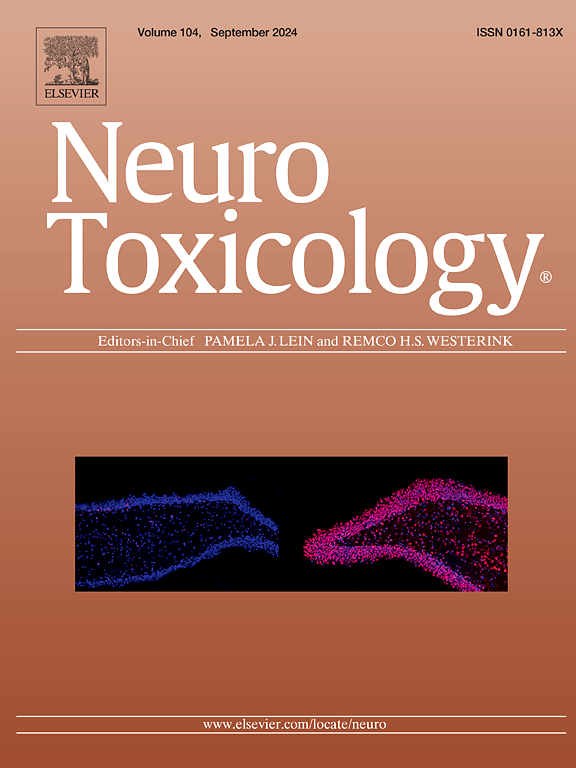Hippocampal apoptosis: Molecular mechanisms triggered by toxic cannabinoid exposure: A narrative review
IF 3.9
3区 医学
Q2 NEUROSCIENCES
引用次数: 0
Abstract
Hippocampal apoptosis is increasingly recognized as a significant consequence of toxic cannabinoid exposure, with profound implications for cognitive function and mental health. This narrative review comprehensively examines the molecular mechanisms underlying cannabinoid-induced apoptosis, focusing on the interplay of various bioactive compounds and their effects on neuronal integrity. We begin by discussing the key players in cannabinoid biology, followed by a synthesis of findings from animal and clinical studies that highlight the neurotoxic potential of cannabinoids. Central to our analysis are the roles of neuroinflammation and oxidative stress, which exacerbate neuronal damage and contribute to cell death. The activation of cannabinoid receptors, particularly CB1 and CB2, is scrutinized for its dual role in mediating neuroprotective and neurotoxic effects. We explore calcium dysregulation as a critical mechanism that leads to excitotoxicity, mitochondrial dysfunction, and the activation of pro-apoptotic pathways. Additionally, we address the inhibition of anti-apoptotic proteins, induction of endoplasmic reticulum (ER) stress, and disruption of neurotransmitter systems, all of which further facilitate apoptosis in hippocampal neurons. Alterations in neurotrophic factor levels are also examined, as they play a vital role in neuronal survival and plasticity. Ultimately, this review underscores the multifaceted nature of cannabinoid-induced hippocampal apoptosis and calls for further research to elucidate these complex interactions, aiming to inform clinical practices and public health policies regarding cannabinoid use. The findings presented herein highlight the urgent need for a nuanced understanding of the risks associated with cannabinoid exposure, particularly in vulnerable populations.
海马细胞凋亡:有毒大麻素暴露引发的分子机制:一篇叙述性综述
海马细胞凋亡越来越被认为是有毒大麻素暴露的重要后果,对认知功能和心理健康具有深远的影响。这篇综述全面探讨了大麻素诱导细胞凋亡的分子机制,重点是各种生物活性化合物的相互作用及其对神经元完整性的影响。我们首先讨论大麻素生物学的主要参与者,然后综合动物和临床研究的结果,强调大麻素的神经毒性潜力。我们分析的核心是神经炎症和氧化应激的作用,它们会加剧神经元损伤并导致细胞死亡。大麻素受体的激活,特别是CB1和CB2,因其在介导神经保护和神经毒性作用中的双重作用而受到审查。我们探索钙失调是导致兴奋性毒性、线粒体功能障碍和促凋亡途径激活的关键机制。此外,我们还研究了抗凋亡蛋白的抑制、内质网应激的诱导和神经递质系统的破坏,所有这些都进一步促进了海马神经元的凋亡。神经营养因子水平的改变也被检查,因为它们在神经元的存活和可塑性中起着至关重要的作用。最后,本综述强调了大麻素诱导的海马细胞凋亡的多面性,并呼吁进一步研究阐明这些复杂的相互作用,旨在为大麻素使用的临床实践和公共卫生政策提供信息。本文提出的研究结果强调了迫切需要细致入微地了解与大麻素暴露相关的风险,特别是在弱势群体中。
本文章由计算机程序翻译,如有差异,请以英文原文为准。
求助全文
约1分钟内获得全文
求助全文
来源期刊

Neurotoxicology
医学-毒理学
CiteScore
6.80
自引率
5.90%
发文量
161
审稿时长
70 days
期刊介绍:
NeuroToxicology specializes in publishing the best peer-reviewed original research papers dealing with the effects of toxic substances on the nervous system of humans and experimental animals of all ages. The Journal emphasizes papers dealing with the neurotoxic effects of environmentally significant chemical hazards, manufactured drugs and naturally occurring compounds.
 求助内容:
求助内容: 应助结果提醒方式:
应助结果提醒方式:


